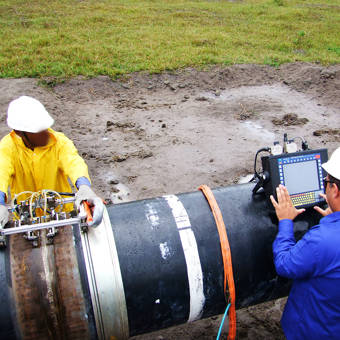Safety First: Comprehensive Pipeline Welding Inspection for each Project Phase
Safety First: Comprehensive Pipeline Welding Inspection for each Project Phase
Blog Article
Important Pipe Welding Evaluation Tips for Quality Control
In the realm of pipe building and construction, the integrity of welds holds paramount value to make certain the safety and effectiveness of the entire system. From all-natural gas to fine-tuned oil products, pipes create the lifeline of various industries. But exactly how can one assure the high quality of these welds that attach the pipe areas? The solution depends on precise assessment methods and adherence to stringent quality guarantee requirements. By recognizing the important pipeline welding evaluation ideas, specialists can avoid possible threats, minimize expensive repair services, and support the dependability of these critical infrastructures.

Significance of Welding Evaluation
Welding inspection plays a crucial role in ensuring the architectural honesty and security of pipe systems. By carefully checking out welds, assessors can determine any kind of problems or imperfections that might compromise the integrity of the pipeline. These inspections are necessary for preventing leakages, ruptures, and other possibly disastrous failures that could result in ecological damages, monetary losses, and even death.
The significance of welding inspection can not be overstated, as the high quality of welds directly impacts the overall performance and long life of the pipe. Through non-destructive testing techniques such as visual assessment, ultrasonic screening, radiography, and magnetic bit screening, examiners can discover problems that might not show up to the naked eye. By identifying and attending to these problems early on, welding inspection helps to guarantee that pipelines satisfy industry criteria and regulatory needs.
Eventually, welding assessment is a crucial element of quality control in pipeline maintenance, building and construction, and repair service (Pipeline Welding Inspection). By promoting rigorous examination criteria, market professionals can minimize risks and promote the safety and security and integrity of pipe systems
Common Welding Problems
Amongst the challenges dealt with in pipeline welding, typical defects can considerably impact the structural integrity and performance of the bonded joints. Some of the most widespread welding problems consist of lack of combination, porosity, splits, insufficient infiltration, and imbalance. Lack of blend takes place when there is inadequate bonding between the weld metal and the base steel, resulting in a weakened joint. Porosity, characterized by gas pockets within the weld, can lower the strength and make the weld vulnerable to corrosion. Fractures in the weld can propagate in time, endangering the structural stability of the pipe. Insufficient penetration happens when the weld steel does not completely pass through the joint, resulting in a weak bond. Misalignment, where the weld bead is not effectively focused, can lead to stress concentration factors and potential failing. Finding and dealing with these common issues through detailed assessment and quality control processes are vital for making certain the integrity and safety and security of pipeline welds.
Evaluation Techniques for Pipes


Non-destructive screening (NDT) techniques such as radiographic screening, ultrasonic screening, magnetic particle testing, and fluid penetrant testing are typically made use of in pipeline welding assessment. Aesthetic inspection is likewise vital in pipeline welding to recognize any type of visible flaws or gaps. In addition, automated evaluation strategies using advanced modern technologies like robotics and drones are significantly being employed to improve the performance and accuracy of pipe assessments.
Guaranteeing Quality Control Criteria
To promote strict quality assurance standards in pipe building, thorough adherence to developed sector methods and guidelines is crucial. Quality guarantee in welding processes requires an extensive method encompassing various stages of pipeline building and construction. Implementing a robust high quality monitoring system that includes regular audits and reviews can further enhance the general high quality assurance standards in pipe welding.
Protecting Against Costly Repairs
Provided the critical relevance of keeping rigorous high quality assurance criteria in pipeline building and construction, a proactive technique to avoiding pricey repair work is crucial. Routine upkeep checks and tracking of ecological aspects that could influence the honesty of the pipeline are additionally essential in preventing expensive repair work. By investing in these details preventative measures and prioritizing quality assurance at every stage of the pipe welding procedure, business can reduce the risk of costly fixings and guarantee the long-term integrity of their facilities.
Verdict
In conclusion, adherence to correct welding evaluation strategies is vital for making sure the high quality and integrity of pipelines. By recognizing common welding defects and implementing complete assessment processes, pricey fixings can be avoided, and quality control criteria can be met - Pipeline Welding Inspection. It is crucial for pipeline welders to prioritize examination treatments to keep the security and dependability of the infrastructure they are dealing with
The relevance of welding evaluation can not be view it now overstated, as the high quality of welds directly affects the overall performance and durability of the pipe. Non-destructive testing (NDT) methods such as radiographic testing, ultrasonic screening, magnetic particle testing, and fluid penetrant click for info testing are generally made use of in pipe welding inspection. Visual examination is additionally crucial in pipeline welding to identify any kind of visible issues or gaps. Furthermore, automated assessment strategies making use of innovative innovations like drones and robotics are progressively being utilized to improve the effectiveness and accuracy of pipeline evaluations.In verdict, adherence to appropriate welding inspection strategies is important for making certain the high quality and integrity of pipes.
Report this page